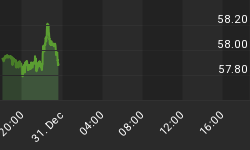The first quarter real GDP estimate of 0.2% was released today. In spite of all the extremely week economic reports lately, economists still could not figure out GDP was going to be near zero. The Bloomberg Consensus estimate was for 1.0%.

Note the lowest estimate was 0.2%. No one predicted negative. Who was it that predicted 2.4%? What planet is that person on?
So what else is there to do but blame the weather?
Heavy weather and the strong dollar took their toll on first-quarter GDP which, at only plus 0.2 percent, came in at the very low end of the Econoday consensus. This compares with an already soft fourth quarter which is unrevised at plus 2.2 percent.
Exports were the heaviest drag on the first quarter reflecting the strong dollar's effect on foreign demand. The heavy weather of the quarter contributed to an outright contraction in business spending (nonresidential fixed investment) and an abrupt slowing in consumer spending (personal consumption expenditures).
Price data, reflecting lower energy prices, are soft with the GDP price index at minus 0.1 percent vs the Econoday consensus for plus 0.5 percent. Prices were also soft in the fourth quarter at an unrevised plus 0.1 percent.
Details include an unwanted surge in inventories tied to lower demand and also possibly to shipment constraints tied to the quarter's West Coast port strike. Imports, likely limited by the port strike, did pull down GDP but to a much lesser extent than the prior quarter (imports are a subtraction in the GDP calculation).
Federal Reserve policy makers, in this afternoon's FOMC statement, may downplay first-quarter weakness as temporary. Nevertheless, the complete lack of punch underway in early second-quarter indicators, together with the softness of the fourth quarter when there were no special factors not to mention the lack of inflationary pressures in the economy, offer plenty of fuel for the doves at the Fed who want to hold off the first signals of a rate increase.
Exports
Gee, who could have predicted Exports would be the heaviest drag?
Let's take a January 31, 2015 flashback look: Diving Into the GDP Report - Some Ominous Trends - Yellen Yap - Decoupling or Not?
Exports added 0.37 percentage points to fourth quarter GDP. But note the trend. Because of the rising US dollar, export growth is dwindling. Will exports add or subtract to GDP next quarter?
I suggest the answer is subtract. Not only are US exports getting more expensive relative to Europe and Japan, the entire rest of the global economy is slowing rapidly. Our biggest trading partner is Canada and Canada is in recession, with a rapidly sinking loonie (Canadian dollar) on top of it. US Recession
The US won't decouple, just as China did not decouple from the global economy in 2008-2009 (a widely-held thesis I also knocked at the time).
Indeed, now that virtually no economist expects a US recession, I believe we are finally on the cusp of one, just as the Fed seems committed to hike.
GDP Details
Let's dive into the First Quarter 2015 (Advance Estimate) report for details.
The increase in real GDP in the first quarter primarily reflected positive contributions frompersonal consumption expenditures (PCE) and private inventory investment that were partly offset by negative contributions from exports, nonresidential fixed investment, and state and local government spending. Imports, which are a subtraction in the calculation of GDP, increased.
The deceleration in real GDP growth in the first quarter reflected a deceleration in PCE, downturns in exports, in nonresidential fixed investment, and in state and local government spending,and a deceleration in residential fixed investment that were partly offset by a deceleration in imports and upturns in private inventory investment and in federal government spending.
The price index for gross domestic purchases, which measures prices paid by U.S. residents, decreased 1.5 percent in the first quarter, compared with a decrease of 0.1 percent in the fourth. Excluding food and energy prices, the price index for gross domestic purchases increased 0.3 percent, compared with an increase of 0.7 percent.
Real personal consumption expenditures increased 1.9 percent in the first quarter, compared withan increase of 4.4 percent in the fourth. Durable goods increased 1.1 percent, compared with an increase of 6.2 percent. Nondurable goods decreased 0.3 percent, in contrast to an increase of 4.1 percent. Services increased 2.8 percent, compared with an increase of 4.3 percent.
The change in real private inventories added 0.74 percentage point to the first-quarter change in real GDP after subtracting 0.10 percentage point from the fourth-quarter change. Private businesses increased inventories $110.3 billion in the first quarter, following increases of $80.0 billion in the fourth quarter and of $82.2 billion in the third.
Real final sales of domestic product -- GDP less change in private inventories -- decreased 0.5 percent in the first quarter, in contrast to an increase of 2.3 percent in the fourth.
Inventories, PCE, Negative Price Deflator
Over time, inventories trend to zero. So the fact that inventories added 0.74 to GDP is not a positive.
Personal consumption expenditures added 1.9% to GDP. Expect that to hold up?
Were it not for a highly questionable negative price deflator, first quarter GDP would have been negative.
With gasoline prices rising, there will be no miracle deflators next quarter.
If I can brag a bit, I nailed this back in January, and economists could not figure it out in spite of weak report after weak report for three more months!
The second estimate of Q1 GDP comes out on May 29. Any number of changes could send Q1 negative.
















